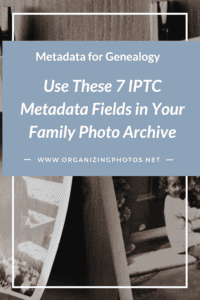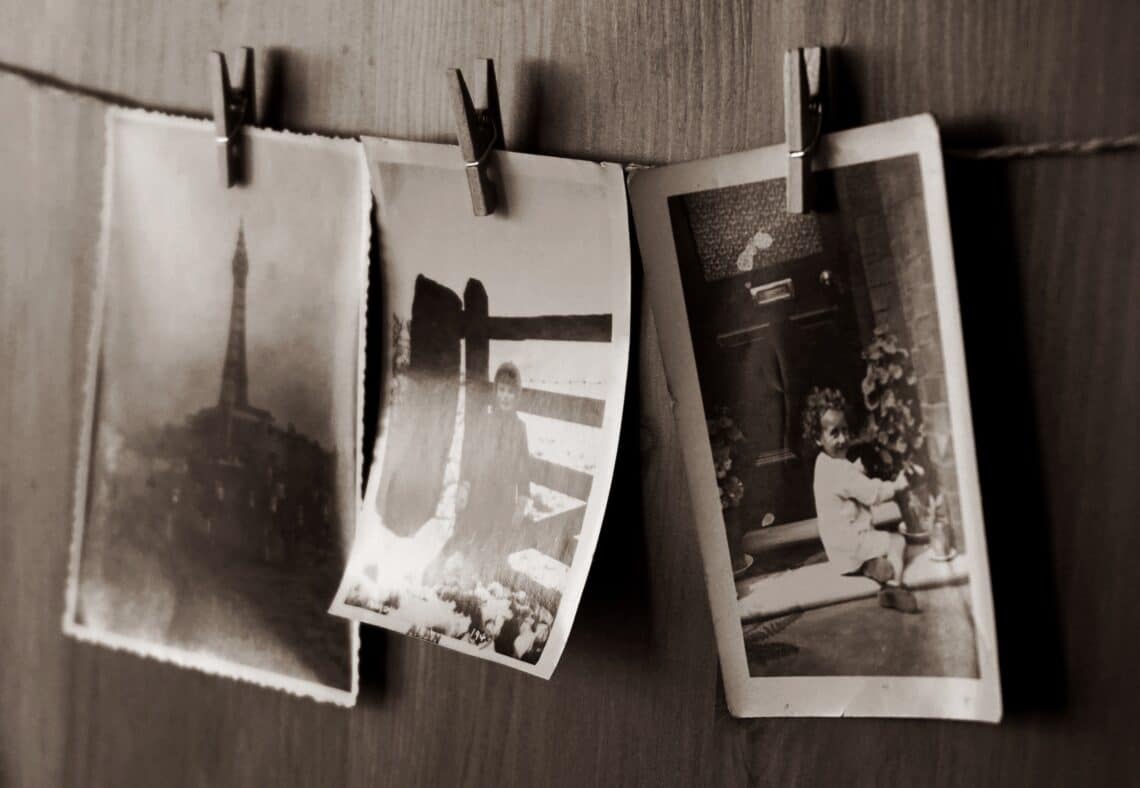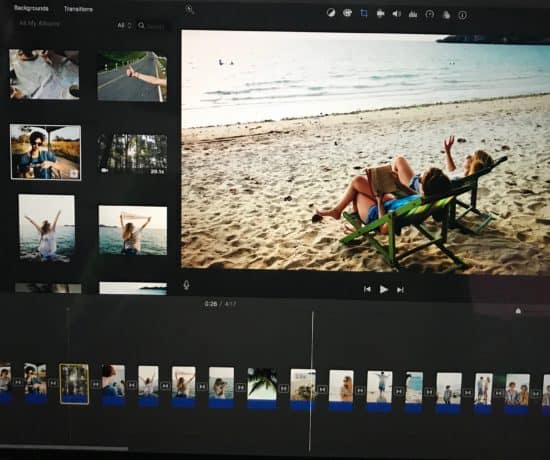Alright, folks, it’s time to tackle which IPTC metadata fields to use in your family photo archive. Ready?
Recently here on the blog, we’ve been talking about why we need to plan out how we’re going to tackle naming conventions in your photo metadata. This is important because without having a solid strategy for how to name people, you’ll be recreating the wheel anytime a new question pops up, and that’s a total waste of time. If you missed any of it, you can find part 1 of this series here and part 2 here.
Let’s now continue this discussion by talking about what IPTC metadata fields are the most important for genealogists and pro photo managers to use in family history documentation. Read on, fellow archiver…and don’t forget to take notes!
The Complete Story? Let’s Tell It.
Just like your photo book or research report needs to tell a complete story, so does your photo metadata. Therefore, we want to use a combination of IPTC metadata fields that answer all the most important questions. We want to know the why, not just the where. We also want to know the who, not just the how. And of course – the when – another piece of information that often gets lost. The date and time a photo is taken is essential to its context.
Standardize Your Photo Metadata Process
So how do we go about answering all these questions? Well, like you may have read in part one of this series, the solution most DIYers default to is the overcomplicated file name. They take all that information and cram it into one long file name. That happens when you’re not sure how else to use metadata, and it’s completely understandable. Still, it’s not the approach you want to take because it’s impossible to format it consistently. Instead, we want to strategize a solid metadata strategy that standardizes how to enter and format metadata in our family photo archive.

I’m a Perfect Pinnable!
The Most Important IPTC Metadata Fields to Use
Anyone familiar with metadata knows just how many IPTC metadata fields there are to fill out, but here’s the thing: it’s not necessary to use all of them. Sure, the more thorough you can be, the better. That being said, fields that were developed for professional photographers and news agencies aren’t always relevant for family history. We just need to use the most pertinent ones that together tell the story.
Below are the ones we recommend that you use – at minimum:
1. Date Created (i.e. When?)
The official IPTC guidelines say that the Date Created field “designates the date and optionally the time the content of the image was created, rather than the date of creation of the digital representation.”
What does this mean? Simply put, you’ll want to enter the date the image was taken. The field right is meant to show when the event took place, the event that’s pictured in the photo, not the date that the photo was digitized.
Why would those be different? Well, for example, if you scanned a photo from 1962 in 2023. In that case, the photo was digitized in 2023, but you’d want to enter 1962 in the Date Created field. Ideally, this should also line up with the EXIF metadata date.
2. Headline (i.e. Who? What? Where? Short Form)
To answer the who, what, and where in short form, we can use the headline field in the metadata. The official guidelines say to “enter a brief publishable synopsis or summary of the contents of the image.” In other words, this field is meant to give you a quick overview of what’s happening in the photo. Think of what you might see in a newspaper article as a headline, and you’ll get the idea.
3. Caption (i.e. Who? What? Where? Long Form)
Everyone knows what a photo caption is, so there’s not much to explain here, except to say that you use the field as the long form version of the headline field. You have some liberties here in terms of really explaining what the photo is depicting. It answers the same questions, but in more detail.
The official IPTC guidelines say: “Enter a caption describing the who, what, and why of what’s happening in the image. This might include names of people and or their role in the action that’s taking place within the image.” What would someone need to read about the photo to understand what’s going on? That’s your caption.
This is also a great place to clarify details that may have been left out by other fields.
4. Location Fields (i.e. Where?)
Naturally, where a photo was taken is a big piece of its context, so I love to use several of the location fields as a group. They can often be imported from the GPS location data in the photo itself, but even if not, it can easily be batched as a template. I regularly recommend using the sub-location, city, state, country, and Country ISO code for best results. If you choose to only use one, pick the city. It’s the piece of information that’ll tell the story the best in absence of other information.
For anything more precise about where the photo was taken vs. what’s shown is also available to fill out, if those two locations are different from each other. That happens quite often, too.
5. Keywords (i.e. Finding the Photo)
I like to spend a lot of time strategizing keywords lists with clients because the keywords are usually where things snowball and get out of control. Keywords are the words that will help you find your photos faster, so it’s worth putting some effort into thinking them through.
In DPO PRO: The Ultimate Photo Organizing Masterclass, we provide students with a complete controlled keyword vocabulary created specifically for family history, so that they don’t have to start from scratch. The reason for this is because it’s a heavier lift to start from scratch. That being said, it can certainly be done. You just have to do it consistently.
6. Creator (i.e. Who Created This?)
The IPTC guideline states that the Creator field should contain the name of the person who created the contents, for example a photographer for photos, or a graphic artist for a graphic, and so on, so it’s usually just the name of the person who took the photo. This is really interesting information to have because it shows the vantage point, and perhaps why the photographer chose to take the photo that day.
There’s a lot of information built into someone’s vantage point, which quite often tells the emotion of the image. If the Creator information is unknown, it’s best to enter the word “Unknown,” to mark that the information isn’t available at this time. That removes confusion as to whether you forgot to enter it or not.
7. Copyright (i.e. Who Owns This?)
The person who took a photo isn’t always the copyright holder, so it’s important to also fill this out. In fact, just from a creative credit-where-credit-is-due standpoint, I believe strongly that Copyright should be entered for all photos everywhere, so we know where things originate. Note that owner, image creator, image source, and licensor may be the same OR DIFFERENT entities.
For family history photos, this is really good to fill in because then people can contact you for more information about photos you share online, for example through Ancestry, MyHeritage, FamilySearch, or other family history websites. Things snowball so quickly online that proving the rights to your photos can otherwise become tricky.
Covering all the Angles in these IPTC Metadata Fields
Together, the above-mentioned fields tell the complete story of when the photo was taken, who was there, where it was, what happened, why it happened, and whose vantage point we are seeing. We also understand who owns the photo, and how to best find it in the archive. That, to me, is covering all the angles in context, which will allow others to enjoy it in the future.
I’d love to hear from you about how you are ensuring that your photo archive covers all the angles too, especially if your approach differs from the one I teach. Let me know in the comments below!
Want to Learn How to Strategize Better?
If you’re interested in learning more about creating your own metadata strategy, consider enrolling in our Metadata for Genealogy Workshop. We held it last year during family history month, and the replay is available for anyone who may have missed it. See the preview below.
This is by far our most popular workshop, and in it, you’ll learn exactly what to consider when putting together your own family archive metadata strategy (simple template included). Naturally, all of my recommendations are in there too, so you have references and a place to start. I go over these metadata fields and examples of use to help you understand my point of view on them.
For more in-depth help that starts from the absolute beginning, consider joining us in our full course DPO PRO: The Ultimate Photo Organizing Masterclass. That’s where we strategize together, and help you through each step of the photo organizing process. We also have private coaching sessions available for anyone who’d like to fool-proof their procedures.
And BONUS! For a limited time, you’ll get the Metadata Workshop for free when you join us. Yep, it’s a two-fer!
In addition to our offers, we highly recommend that you visit IPTC.org for learning about these seven fields and much more. Join us again in the next post to continue the conversation on what metadata to use for your family photos and genealogy.
Featured Photo Courtesy of Suzy Hazelwood





